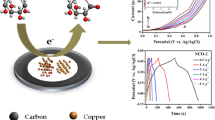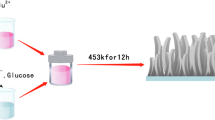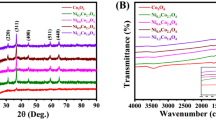Abstract
Advanced energy storage has driven significant research in the field of energy storage, which bridges the gap between traditional capacitors and batteries in terms of energy and power density. This study investigates the electrochemical performance of copper–nickel sulfide (CuNiS) for supercapacitor applications. Carbon nanotubes (CNTs) are doped into CuNiS mixture to improve the electrical conductivity and capacitive characteristics. The study aimed to determine whether CuNiS/CNTs nanocomposite material was suitable for supercapacitor devices through synthesis, characterization, and electrochemical analysis studies. The hydrothermal method was used to create the composite material, which then went through several characterization processes, such as scanning electron microscopy (SEM) and x-ray diffraction (XRD), to study its morphology and structural properties. The specific capacity of binary composite CuNiS shows 638 C/g; when CuNiS material is doped with 20% CNTs, the specific capacity increases to 1173.69 C/g at the same current density of 1.8 A/g. Additionally, we created a supercapattery device (CuNiS@CNTs//AC) and examined its electrochemical properties. The supercapattery device displays a high coulombic efficiency of 82.69%, an exceptional energy density of 23.51 Wh/kg and a strong power density of 1289.58 W/kg after 7000 GCD cycles. Besides, the composite electrode is used as a non-enzymatic electrochemical glucose sensor. The electrode showed high sensitivity and performance against glucose detection. The nanocomposite electrode materials provide an opportunity to design highly efficient and multifunctional devices.









Similar content being viewed by others
Data availability
The data are available on request.
References
K.K. Jaiswal, C.R. Chowdhury, D. Yadav, R. Verma, S. Dutta, K.S. Jaiswal, K.S.K. SangmeshB, Karuppasamy, Renewable and sustainable clean energy development and impact on social, economic, and environmental health. Energy Nexus. 7, 100118 (2022)
J.S. Riti, Y. Shu, Energy Sustain. Soc. 6(1), 1–16 (2016)
Y. Gogotsi, P. Simon, Science 334, 917–918 (2011)
D. Larcher, J.-M. Tarascon, Towards greener and more sustainable batteries for electrical energy storage. Nat. Chem. 7, 19–29 (2015)
P. Simon, Y. Gogotsi, B. Dunn, Where do batteries end and supercapacitors begin? Science. 343, 1210–1211 (2014)
Q. Lu, Supercapacitor Electrodes with High-energy and power densities prepared from monolithic NiO/Ni Nanocomposite, APS March Meeting Abstracts, 2012, pp. B26. 009
L.L. Zhang, X. Zhao, Carbon-based materials as supercapacitor electrodes. Chem. Soc. Rev. 38, 2520–2531 (2009)
Y. Liu, Y. Shi, X. Xu, Evolution and application of all-in-one electrochemical energy storage system. Energy Storage Mater. 41, 677–696 (2021)
V. Molahalli, C. K, M.K. Singh, M. Agrawal, S.G. Krishnan, G. Hegde, Past decade of supercapacitor research – lessons learned for future innovations. J. Energy Storage. 70, 108062 (2023)
S. Shahabuddin, A. Numan, M.M. Shahid, R. Khanam, R. Saidur, A. Pandey, S. Ramesh, Polyaniline-SrTiO3 nanocube based binary nanocomposite as highly stable electrode material for high performance supercapaterry. Ceram. Int. 45, 11428–11437 (2019)
M. Imran, M.W. Iqbal, A.M. Afzal, M.M. Faisal, H.A. Alzahrani, Synergetic electrochemical performance of nix–mnx sulfide-based binary electrode material for supercapattery devices. J. Appl. Electrochem. 53, 1125–1136 (2023)
F.S. Omar, A. Numan, N. Duraisamy, S. Bashir, K. Ramesh, S. Ramesh, A promising binary nanocomposite of zinc cobaltite intercalated with polyaniline for supercapacitor and hydrazine sensor. J. Alloys Compd. 716, 96–105 (2017)
A.M. Afzal, M. Ali, M.W. Iqbal, M. Imran, A. Ur Rehman, S. Mumtaz, J.S. Kim, E.H. Choi, Mohammed Alanazi, enhanced the electrochemical performance and stability of supercapattery device with carbon nanotube/cobalt-manganese sulfide‐based composite electrode material. Int. J. Energy Res. 46, 24355–24367 (2022)
A.U. Rehman, A.M. Afzal, M.W. Iqbal, M. Ali, S. Mohammad Wabaidur, E.A. Al-Ammar, M. Imran, S. Mumtaz, E. Ha Choi, N. Muzaffar, Synergetic and Anomalous Effect of CNTs in the sulphide-based Binary Composite for an Extraordinary and Asymmetric Supercapacitor Device (The Canadian Journal of Chemical Engineering, n/a, 2023)
R. Khan, A.M. Afzal, Z. Hussain, M.W. Iqbal, M. Imran, M. Hamza Waris, M. Azhar Mumtaz, M. Usman, S.M. Wabaidur, E.A. Al-Ammar, S. Mumtaz, MnNbS/Polyaniline Composite-Based Electrode Material for High-Performance Energy Storage Hybrid Supercapacitor Device. physica Status Solidi (a) 220(15), 2300200 (2023)
A.M. Afzal, T. Ejaz, M.W. Iqbal, B.S. Almutairi, M. Imran, A. Manzoor, H.H. Hegazy, A. Yasmeen, A. Zaka, T. Abbas, Enhancing the Performance of Cobalt-based Oxide Electrode Material for Asymmetric Supercapacitor Devices. ChemistrySelect 8, e202300440 (2023)
F. Aslam, H. Ullah, M. Hassan, First principle study of band gap tuning in Cs2InSbX6 (X = cl, br, I) for optoelectronic and thermoelectric applications. Phys. Scr. 97, 045801 (2022)
H. Ullah, M. Noor-A‐Alam, Y.H. Shin, Vacancy‐and doping‐dependent electronic and magnetic properties of monolayer SnS2. J. Am. Ceram. Soc. 103, 391–402 (2020)
A.G. Olabi, Q. Abbas, A. Al Makky, M.A. Abdelkareem, Supercapacitors as next generation energy storage devices: Properties and applications. Energy. 248, 123617 (2022)
H.M. Waris, R. Khan, A.M. Afzal, M.W. Iqbal, M. Imran, M. Azhar, M. Usman, A.A. Ghfar, S. Mumtaz, Z. Hussain, Composite electrode materials based on nickel cobalt sulfide/carbon nanotubes to enhance the Redox activity for high performance asymmetric supercapacitor devices. Physica Scripta 98, 105979 (2023)
S. Subhadarshini, E. Pavitra, G.S. Rama Raju, N.R. Chodankar, A. Mandal, S. Roy, S. Mandal, M.V.B. Rao, D.K. Goswami, Y.S. Huh, N.C. Das, One-pot facile synthesis and electrochemical evaluation of selenium enriched cobalt selenide nanotube for supercapacitor application. Ceram. Int. 47, 15293–15306 (2021)
K. Kraiwattanawong, A review on the development of a porous carbon-based as modeling materials for electric double layer capacitors. Arab. J. Chem. 15, 103625 (2022)
M. Sk, P. Pradhan, B. Patra, A. Guria, Green biomass derived porous carbon materials for electrical double-layer capacitors (EDLCs). Mater. Today Chem. 30, 101582 (2023)
M. Imran, A.M. Afzal, M.W. Iqbal, H.H. Hegazy, M.Z. Iqbal, S. Mumtaz, R. Qureshi, Manganese (Sulfide/Oxide) based electrode materials advancement in supercapattery devices. Mater. Sci. Semiconduct. Process. 158, 107366 (2023)
A.M. Afzal, M.W. Iqbal, M. Imran, H. Umair, S.M. Wabaidur, E.A. Al-Ammar, S. Mumtaz, E.H. Choi, Synthesis of CoNbS, PANI@CoNbS, and PANI@AC composite and study of the impact of PANI on the Electrochemical Characteristics of Energy Storage Device. ECS J. Solid State Sci. Technol. 12, 051003 (2023)
Y. Quan, G. Wang, L. Lu, Z. Wang, H. Xu, S. Liu, D. Wang, High-performance pseudo-capacitor energy storage device based on a hollow-structured copper sulfide nanoflower and carbon quantum dot nanocomposite. Electrochim. Acta. 353, 136606 (2020)
M.Z. Iqbal, M.M. Faisal, S.R. Ali, A.M. Afzal, M.R.A. Karim, M.A. Kamran, T. Alharbi, Strontium phosphide-polyaniline composites for high performance supercapattery devices. Ceram. Int. 46, 10203–10214 (2020)
R. Kihal, H. Fisli, M.L. Chelaghmia, W. Drissi, C. Boukharouba, S. Abdi, M. Nacef, A.M. Affoune, M. Pontié, A novel and ultrasensitive non-enzymatic electrochemical glucose sensor in real human blood samples based on facile one-step electrochemical synthesis of nickel hydroxides nanoparticles onto a three-dimensional Inconel 625 foam. J. Appl. Electrochem. 53, 315–329 (2023)
A. Singh, A. Sharma, A.K. Sundramoorthy, S. Arya, Synthesis and characterization of wearable cuprous oxide/conductive fabric enabled non-enzymatic electrochemical sensing of glucose. Ionics. 29, 2501–2513 (2023)
S. Ramesh, K. Karuppasamy, Y. Haldorai, A. Sivasamy, H.-S. Kim, H.S. Kim, Hexagonal nanostructured cobalt oxide@ nitrogen doped multiwalled carbon nanotubes/polypyyrole composite for supercapacitor and electrochemical glucose sensor. Colloids Surf., B 205, 111840 (2021)
M. Bilal, Z.U. Rehman, J. Hou, S. Ali, S. Ullah, J. Ahmad, 2 - Metal oxide–carbon composite: synthesis and properties by using conventional enabling technologies, in: M.A. Chaudhry, R. Hussain, F.K. Butt (Eds.) Metal Oxide-Carbon Hybrid Materials, Elsevier2022, pp. 25–60
N. Duraisamy, A. Numan, K. Ramesh, K.-H. Choi, S. Ramesh, Investigation on structural and electrochemical properties of binder free nanostructured nickel oxide thin film. Mater. Lett. 161, 694–697 (2015)
R. Kumar, K. Singh, P. Kumar, A. Kaur, Highly porous activated carbon prepared from the bio-waste of yellow mustard seed for high-capacity supercapacitor applications. Mater. Chem. Phys. 304, 127869 (2023)
N. Balis, V. Dracopoulos, K. Bourikas, P. Lianos, Quantum dot sensitized solar cells based on an optimized combination of ZnS, CdS and CdSe with CoS and CuS counter electrodes. Electrochim. Acta. 91, 246–252 (2013)
K.D. Ikkurthi, S.S. Rao, M. Jagadeesh, A.E. Reddy, T. Anitha, H.-J. Kim, Synthesis of nanostructured metal sulfides via a hydrothermal method and their use as an electrode material for supercapacitors. New J. Chem. 42, 19183–19192 (2018)
G. He, M. Qiao, W. Li, Y. Lu, T. Zhao, R. Zou, B. Li, J.A. Darr, J. Hu, M.M. Titirici, S, N-Co‐doped graphene‐nickel cobalt sulfide aerogel: improved energy storage and electrocatalytic performance. Adv. Sci. 4, 1600214 (2017)
I. Hussain, D. Mohapatra, G. Dhakal, C. Lamiel, S.G. Mohamed, M.S. Sayed, Y.R. Lee, J. Lee, M. Lee, J.-J. Shim, Growth of 2D nanoflakes from 1D long leaf arrays: Electrochemical influence of copper and nickel co-substituted cobalt oxide. J. Energy Storage. 32, 101871 (2020)
M.A. Mumtaz, A.M. Afzal, M.W. Iqbal, A.A. Ifseisi, S. Mumtaz, M. Imran, M. Usman, Z. Hussain, M.H. Waris, P. Lamichhane, Enhancing the charge transfer and redox characteristics in energy storage devices with a layered ZnNbS@graphene nanocomposite electrode material for biomedical application. Diam. Relat. Mater. 140, 110519 (2023)
M. Imran, M.H. Waris, R. Khan, A.M. Afzal, M.W. Iqbal, M.A. Mumtaz, A.A. Ghfar, A. Ali, S. Mumtaz, Z. Hussain, High-performance energy storage hybrid supercapacitor device based on NiCoS@CNT@graphene composite electrode material. Phys. Scr. 98, 115981 (2023)
A.U. Rehman, A.M. Afzal, M.W. Iqbal, M. Ali, S. Mohammad Wabaidur, E.A. Al-Ammar, M. Imran, S. Mumtaz, E. Ha Choi, N. Muzaffar, Synergetic and Anomalous Effect of CNTs in the sulphide-based Binary Composite for an Extraordinary and Asymmetric Supercapacitor Device, The Canadian Journal of Chemical Engineering, n/a
W. Zheng, B. Han, E. Siyu, Y. Sun, X. Li, Y. Cai, Y.-. Zhang, Highly-sensitive and reflective glucose sensor based on optical fiber surface plasmon resonance. Microchem. J. 157, 105010 (2020)
J. Tang, L. Wei, S. He, J. Li, D. Nan, L. Ma, W. Shen, F. Kang, R. Lv, Z. Huang, A highly sensitive electrochemical glucose sensor based on room temperature exfoliated graphite-derived film decorated with dendritic copper. Materials. 14, 5067 (2021)
G. Das, T.Q.N. Tran, H.H. Yoon, Spherulitic copper–copper oxide nanostructure-based highly sensitive nonenzymatic glucose sensor. Int. J. Nanomed. 10, 165–178 (2015)
F. Doroftei, T. Pinteala, A. Arvinte, Enhanced stability of a prussian blue/sol-gel composite for electrochemical determination of hydrogen peroxide. Microchim. Acta. 181, 111–120 (2014)
T. Shimomura, T. Sumiya, M. Ono, T. Ito, T.-. Hanaoka, Amperometric L-lactate biosensor based on screen-printed carbon electrode containing cobalt phthalocyanine, coated with lactate oxidase-mesoporous silica conjugate layer. Anal. Chim. Acta. 714, 114–120 (2012)
J. Yang, W.-D. Zhang, S. Gunasekaran, An amperometric non-enzymatic glucose sensor by electrodepositing copper nanocubes onto vertically well-aligned multi-walled carbon nanotube arrays. Biosens. Bioelectron. 26, 279–284 (2010)
X.-C. Dong, H. Xu, X.-W. Wang, Y.-X. Huang, M.B. Chan-Park, H. Zhang, L.-H. Wang, W. Huang, P. Chen, 3D graphene–cobalt oxide electrode for high-performance supercapacitor and enzymeless glucose detection. ACS nano. 6, 3206–3213 (2012)
M. Li, C. Han, Y. Zhang, X. Bo, L. Guo, Facile synthesis of ultrafine Co3O4 nanocrystals embedded carbon matrices with specific skeletal structures as efficient non-enzymatic glucose sensors. Anal. Chim. Acta. 861, 25–35 (2015)
Acknowledgements
This work was funded by the Researchers Supporting Project Number (RSP2023R441), King Saud University, Riyadh, Saudi Arabia.
Funding
This work was funded by the Researchers Supporting Project Number (RSP2023R441), King Saud University, Riyadh, Saudi Arabia.
Author information
Authors and Affiliations
Contributions
MI, KQ, and AMA worked on experiment, data collection, analysis, and interpretation of results. MI, KQ, and AMA performed the calculation and write the manuscript. MI, KQ, AMA, MWI, SM, SAM, MAH, SS, WF, and MZA helped during the calculation process and reviewed the manuscript.
Corresponding authors
Ethics declarations
Competing interests
The authors declare that they have no conflicts of interest. The submitted work should be original and should not have been published elsewhere in any form or language.
Additional information
Publisher’s Note
Springer Nature remains neutral with regard to jurisdictional claims in published maps and institutional affiliations.
Rights and permissions
Springer Nature or its licensor (e.g. a society or other partner) holds exclusive rights to this article under a publishing agreement with the author(s) or other rightsholder(s); author self-archiving of the accepted manuscript version of this article is solely governed by the terms of such publishing agreement and applicable law.
About this article
Cite this article
Imran, M., Qasam, K., Safdar, S. et al. Hydrothermally synthesized CuNiS@CNTs composite electrode material for hybrid supercapacitors and non-enzymatic electrochemical glucose sensor. J Mater Sci: Mater Electron 35, 441 (2024). https://doi.org/10.1007/s10854-024-12197-0
Received:
Accepted:
Published:
DOI: https://doi.org/10.1007/s10854-024-12197-0




